The morning ritual in your master bathroom should feel like stepping into a personal sanctuary, not navigating an outdated maze of cramped fixtures and tired finishes. Yet for many homeowners, the prospect of a bathroom remodel master project feels overwhelming—a tangle of plumbing mysteries, design decisions, and budget concerns that can paralyze even the most determined renovator. The truth is, transforming your master bath from functional afterthought to luxurious retreat requires more than just selecting pretty tiles and hoping for the best.
What separates a successful bathroom remodel master project from a costly disaster lies in understanding the intricate dance between form and function, between dreams and practical limitations. This comprehensive guide cuts through the confusion with 23 battle-tested strategies that address everything from hidden plumbing pitfalls to future-proofing your investment. Whether you’re working with a compact space or a generous footprint, these insights will help you navigate the complexities while creating a space that enhances your daily life and adds lasting value to your home.
1. Mastering the Master Bathroom Layout Plan
The craftsmanship reveals itself in details like how traffic flows seamlessly between your vanity and shower, or how natural light plays across carefully positioned fixtures throughout the day. A well-planned layout forms the backbone of any successful bathroom remodel master project, dictating everything from plumbing placement to the final aesthetic impact. Without this foundation, even the most expensive materials and fixtures can feel awkward and inefficient in daily use.
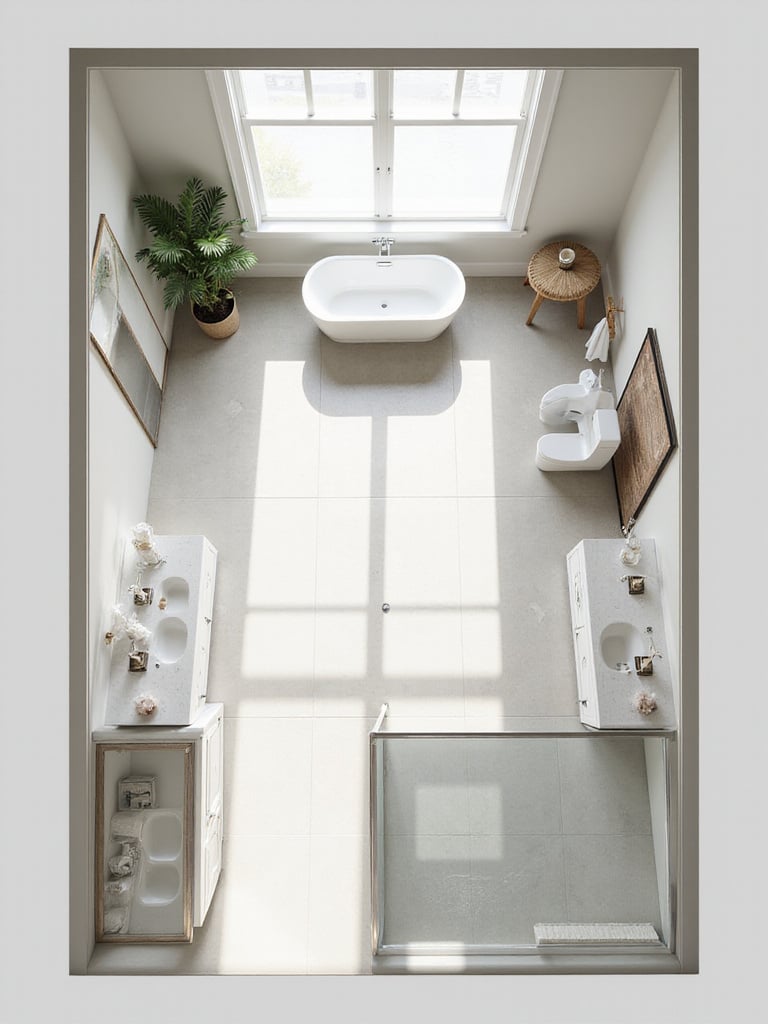
Consider zoning your space by function: create distinct areas for bathing, grooming, and privacy that work harmoniously together. The “wet zone” houses your shower and tub, while the “vanity zone” becomes your daily preparation headquarters. This approach not only improves workflow but can make even modest spaces feel more spacious and organized. Remember that existing plumbing lines and structural elements will significantly influence your options—moving a toilet drain typically represents the most complex and expensive change you can make.
Understanding these constraints early helps you make informed decisions about where to invest your budget for maximum impact.
2. Setting Your Budget: The Foundation of a Successful Master Remodel
Beyond aesthetics, the ecological impact matters because a realistic budget prevents the financial stress that can derail even the most well-intentioned bathroom remodel master project. Your budget serves as both compass and guardrail, guiding material choices while preventing costly scope creep that transforms a manageable renovation into a financial burden.
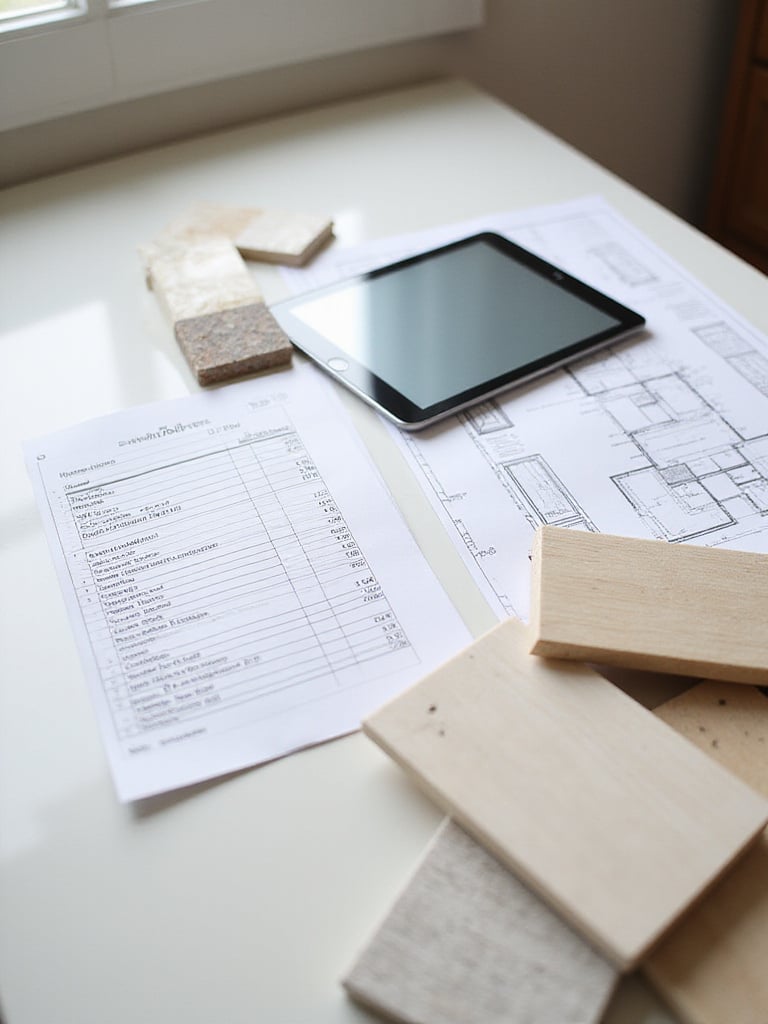
Master bathroom remodel costs vary dramatically—from $15,000 for a basic refresh to $75,000 or more for luxury renovations. The key lies in understanding where your money delivers the greatest impact. Allocate your largest portions to elements that are difficult to change later: plumbing, electrical work, and waterproofing. Next, focus on fixtures and finishes that endure heavy daily use. Always reserve 15-20% of your total budget for unexpected discoveries like outdated wiring or water damage lurking behind walls.
With your financial framework established, the exciting process of selecting materials that bring your vision to life can begin.
3. Choosing Durable & Stylish Materials for Your Retreat
The interplay between the colors creates a foundation that must withstand years of moisture, daily use, and changing design trends. Material selection for your bathroom remodel master project requires balancing aesthetic desires with practical performance—a beautiful marble floor loses its appeal quickly if it stains from every dropped bottle of shampoo.
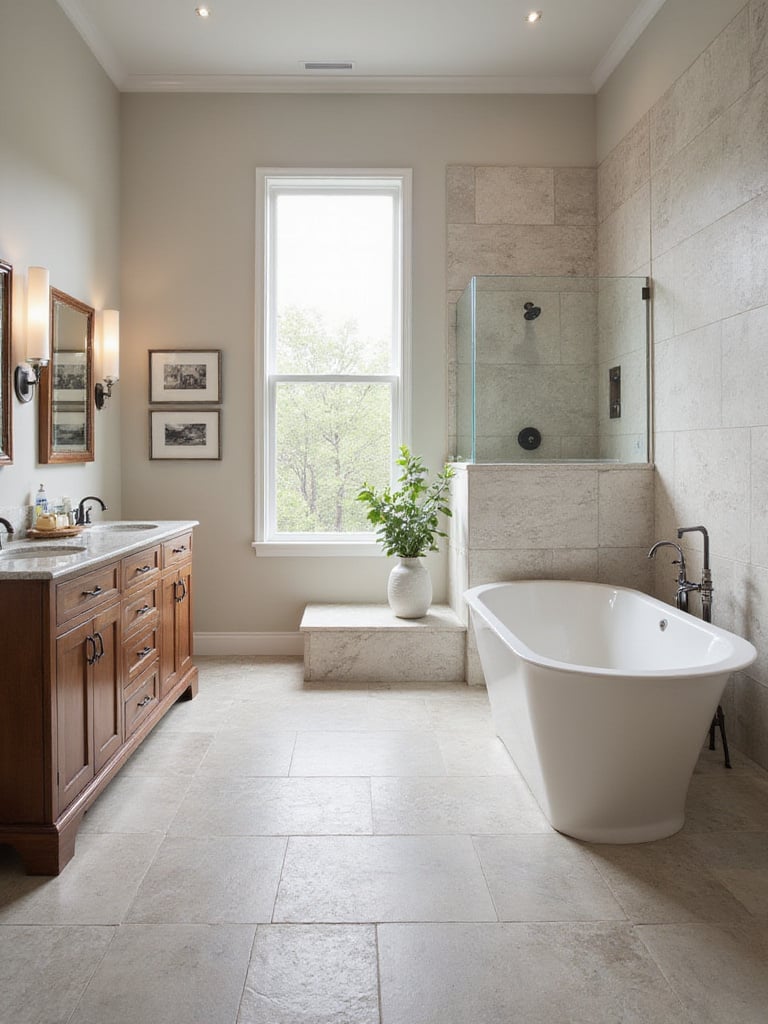
Porcelain tile emerges as the champion for most bathroom applications, offering superior water resistance, durability, and an endless array of styles. For countertops, quartz provides the perfect marriage of beauty and resilience, while natural stone demands more maintenance but delivers unmatched character. Consider how different textures and finishes will feel underfoot and to the touch—matte surfaces hide water spots better, while polished finishes reflect more light in smaller spaces.
• Flooring: Porcelain tile, luxury vinyl plank, or natural stone with proper sealing • Walls: Large-format tile in wet areas, moisture-resistant paint elsewhere • Countertops: Quartz for durability, natural stone for character • Shower surrounds: Porcelain tile with minimal grout lines
Smart material choices create the foundation for fixtures that complete your functional and aesthetic vision.
4. Selecting the Perfect Fixtures: Toilets, Sinks, & More
What makes this design special is the way each fixture contributes to both daily function and overall style in your bathroom remodel master suite. Modern toilets offer features ranging from comfort height and dual-flush efficiency to smart technology with heated seats and integrated bidets. Your choice impacts not just aesthetics but long-term satisfaction and maintenance requirements.

Sink selection depends heavily on your space and storage needs. Undermount sinks create clean lines and easy countertop cleaning, while vessel sinks make dramatic style statements. Consider how the sink pairs with your chosen faucet—a tall vessel sink requires a different faucet height than a traditional drop-in model. For faucets and other hardware, choose a consistent finish throughout the space to create visual cohesion.
The shower represents perhaps the greatest opportunity to create a truly luxurious experience within your remodel.
5. Designing Your Dream Shower Experience
The unexpected pairing that always works is combining multiple shower heads with thoughtful lighting to create a spa-like atmosphere that transforms your daily routine. Your shower design can range from a simple alcove with upgraded tile to an elaborate multi-head system with steam capabilities—the key lies in matching features to your actual usage patterns and maintenance preferences.
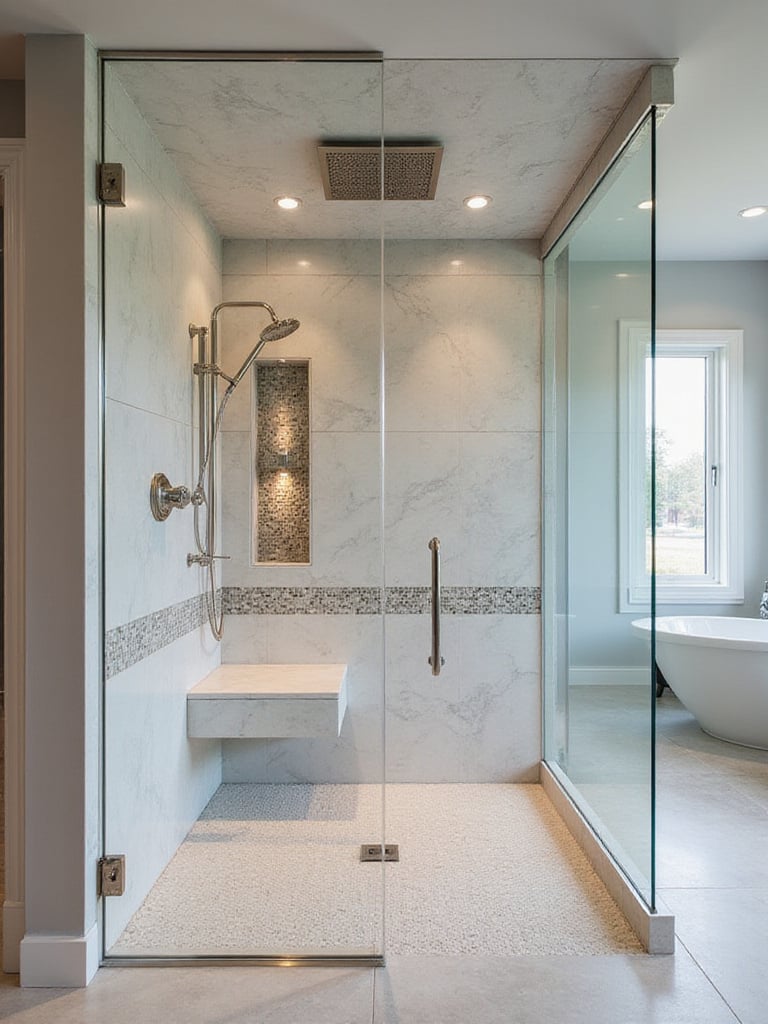
Rain heads provide that luxurious drenching sensation but typically offer lower pressure than traditional heads. Handheld units add versatility for cleaning and targeted rinsing. Body jets create a massage-like experience but significantly increase water usage and installation complexity. Consider installing a thermostatic valve to maintain consistent temperature, especially important with multiple outlets. Proper lighting within the shower—using waterproof fixtures rated for wet locations—enhances both safety and ambiance.
While an exceptional shower experience is essential, many find their master bath incomplete without the option for a relaxing soak.
6. The Allure of a Freestanding Tub: Is It Right for You?
The artisan collective that creates these pieces understands how a freestanding tub can serve as both functional fixture and sculptural centerpiece in your bathroom remodel master design. These tubs offer unparalleled flexibility in placement—imagine positioning yours beneath a window with a view or in the center of the room for maximum visual impact.

However, freestanding tubs require careful planning for plumbing access and typically demand more floor space than built-in alternatives. Installation costs often exceed those of standard tubs due to the need for floor-mounted or wall-mounted faucets and specialized drain connections. Consider whether you’ll actually use the tub regularly—many homeowners discover that their soaking habits don’t match their renovation dreams.
Whether you choose a freestanding tub or built-in option, the vanity area remains central to daily function and storage needs.
7. Vanity Power: Storage & Style Combined
Even in smaller spaces, here’s how this works: a thoughtfully designed vanity can provide ample storage while serving as the visual anchor for your entire bathroom remodel master project. The choice between floating, freestanding, or console-style vanities dramatically impacts both storage capacity and the perceived spaciousness of your room.
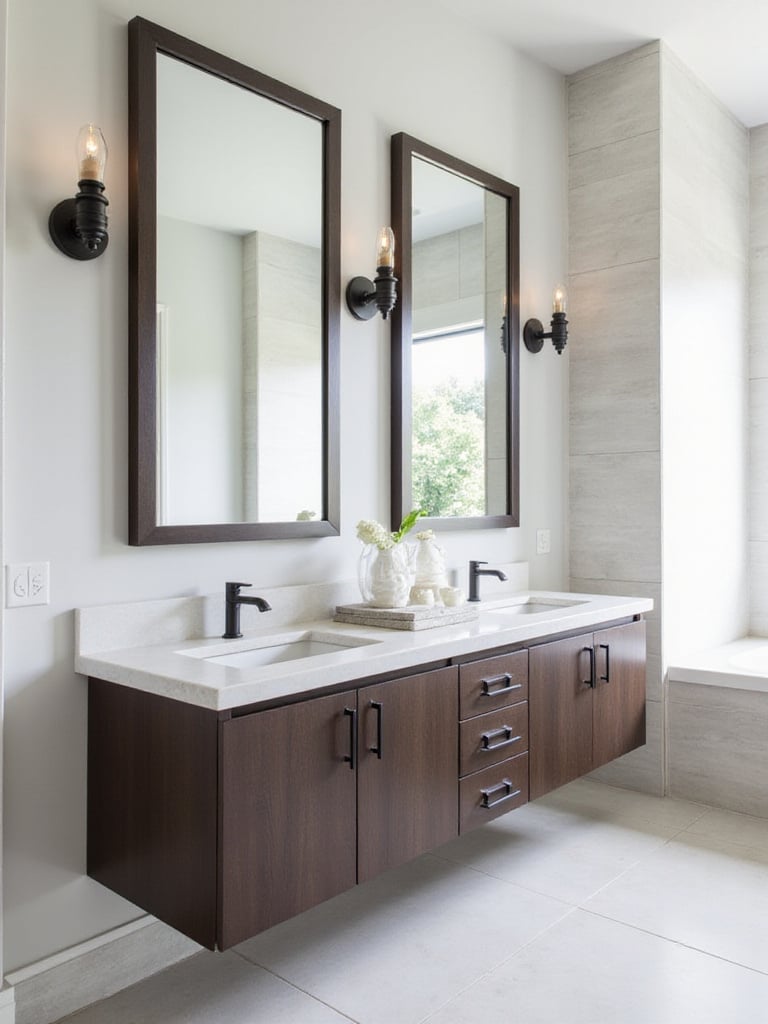
Double vanities prove essential for shared master baths, eliminating morning bottlenecks while providing dedicated storage for each person’s belongings. Consider incorporating smart storage solutions like pull-out drawers with built-in dividers, electrical outlets inside drawers for charging devices, or tilt-out trays that provide access to plumbing while hiding cleaning supplies. The vanity material choice affects both durability and style—solid wood offers warmth and character, while engineered materials often provide better moisture resistance.
Proper lighting around your vanity ensures this hardworking area functions beautifully at any hour.
8. Illuminate Your Space: Essential Bathroom Lighting Tips
The composition comes together when you layer different types of lighting to create a space that adapts to various needs and moods throughout the day. Effective bathroom lighting goes far beyond a single overhead fixture—your bathroom remodel master plan should incorporate ambient, task, and accent lighting for optimal function and atmosphere.
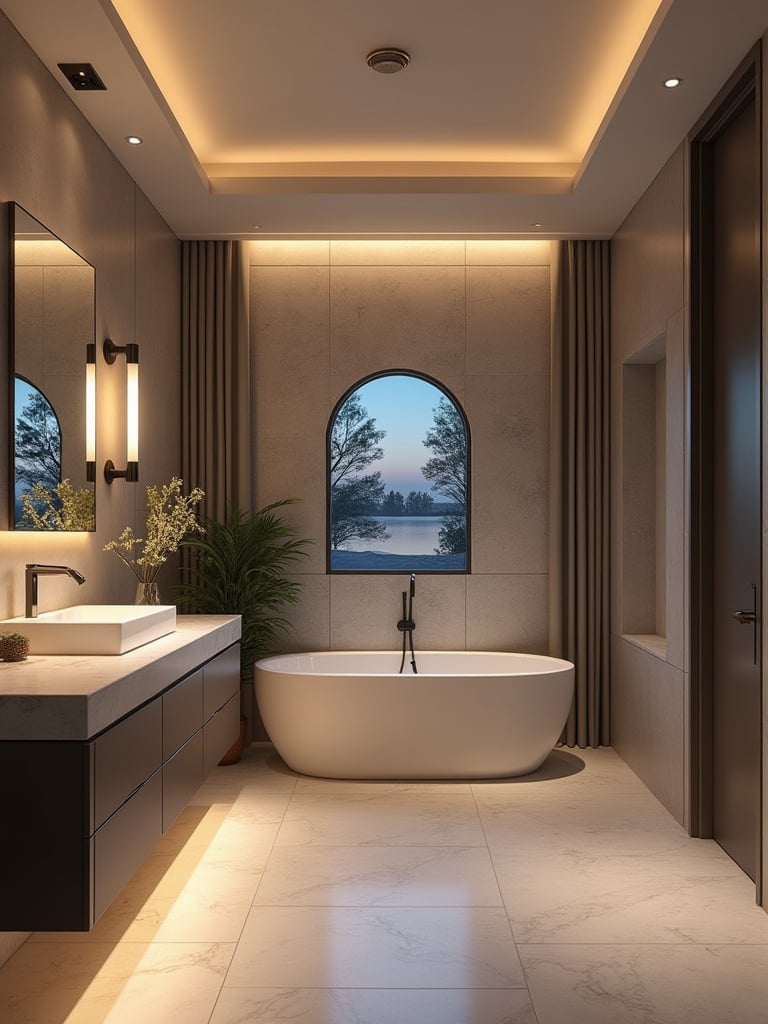
Vanity lighting deserves special attention since this is where detailed grooming tasks occur. Sconces mounted on either side of the mirror at eye level provide the most flattering, shadow-free illumination. If side mounting isn’t possible, choose a fixture that spans at least the width of your mirror. Dimmer switches throughout the space allow you to transition from bright task lighting to soft ambient lighting for relaxation.
• Ambient lighting: Recessed ceiling fixtures or decorative pendants • Task lighting: Vanity sconces or above-mirror fixtures • Accent lighting: LED strips under floating vanities or in niches • Smart features: Programmable scenes and voice control integration
Just as proper lighting enhances every surface, effective ventilation protects your investment from moisture damage.
9. Breathe Easy: Why Ventilation Matters in a Master Bath
The sustainable journey of this material involves understanding how proper ventilation prevents the costly moisture damage that can undermine even the most beautiful bathroom remodel master project. Humidity levels during hot showers can reach 100%, creating perfect conditions for mold growth, paint failure, and structural damage without adequate air circulation.
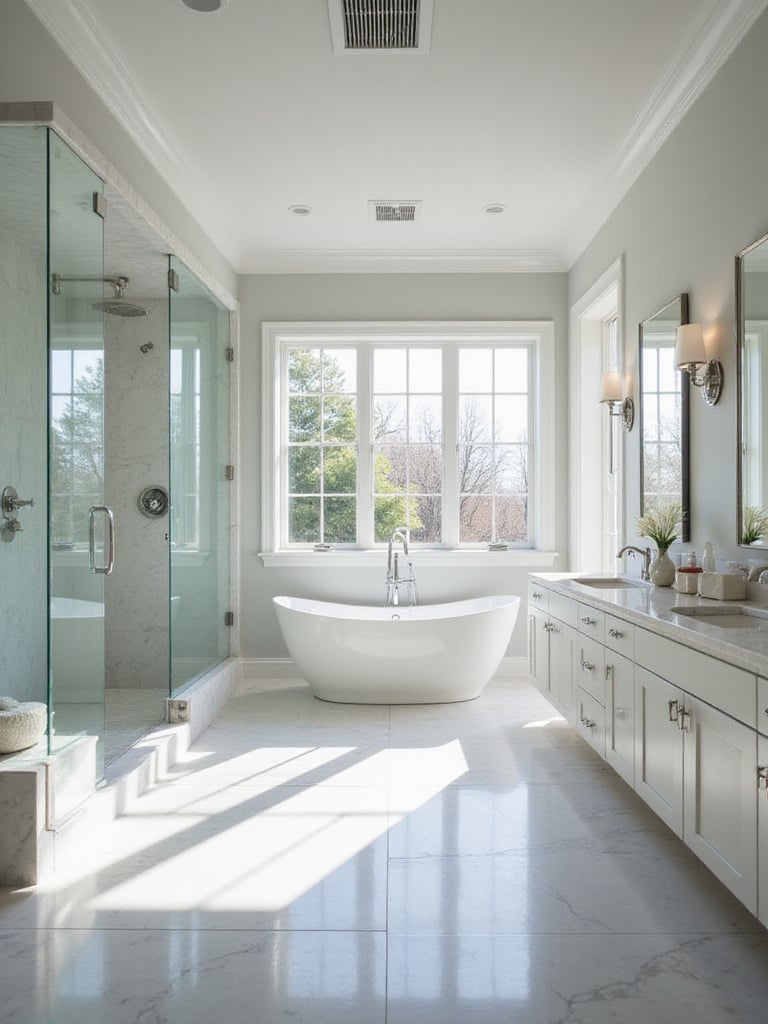
Mechanical ventilation through properly sized exhaust fans provides the most reliable moisture control. Calculate at least 1 CFM (cubic feet per minute) per square foot of bathroom area, with higher ratings for spaces featuring steam showers or limited natural ventilation. Modern fans offer features like humidity sensors that automatically activate when moisture levels rise, and ultra-quiet operation that encourages regular use.
With air quality managed, attention turns to the foundation beneath your feet—the flooring that anchors your entire design.
10. Step Up Your Style: Choosing the Best Bathroom Flooring
The materials are sourced from a remarkable region where durability meets beauty, making flooring selection crucial for your bathroom remodel master success. Your floor must withstand constant moisture exposure while providing safe footing and contributing to your overall aesthetic vision.
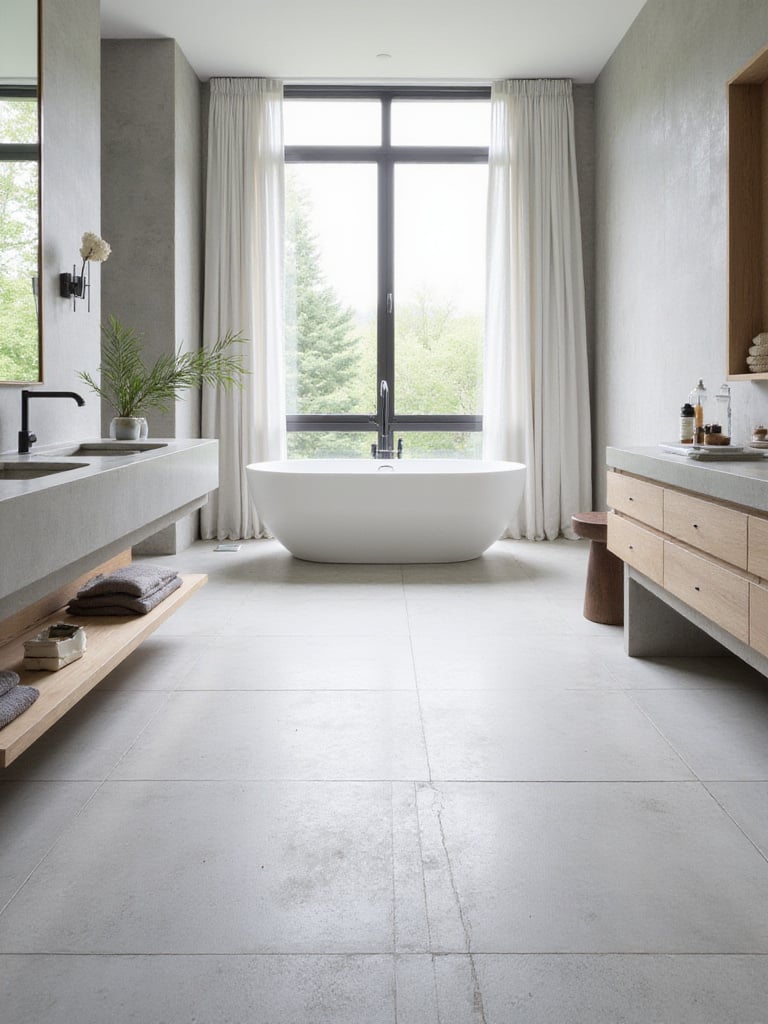
Porcelain tile leads the field for its superior water resistance and vast design options, including large formats that minimize grout lines for easier maintenance. Luxury vinyl plank offers 100% waterproofing with the warmth and comfort that tile lacks. Natural stone provides unmatched beauty but requires ongoing sealing and maintenance. Consider slip resistance ratings, especially in wet areas—textured surfaces or smaller tiles with more grout lines provide better traction.
From the foundation up, walls offer another canvas for expressing your design vision and protecting against moisture.
11. Wall Wow Factors: From Tile Trends to Paint Perfection
The cultural heritage preserved in each piece includes understanding how wall treatments can transform your bathroom remodel master project from purely functional to genuinely inspiring. Current trends favor large-format tiles that create seamless, spa-like surfaces, while textured tiles add tactile interest and visual depth.
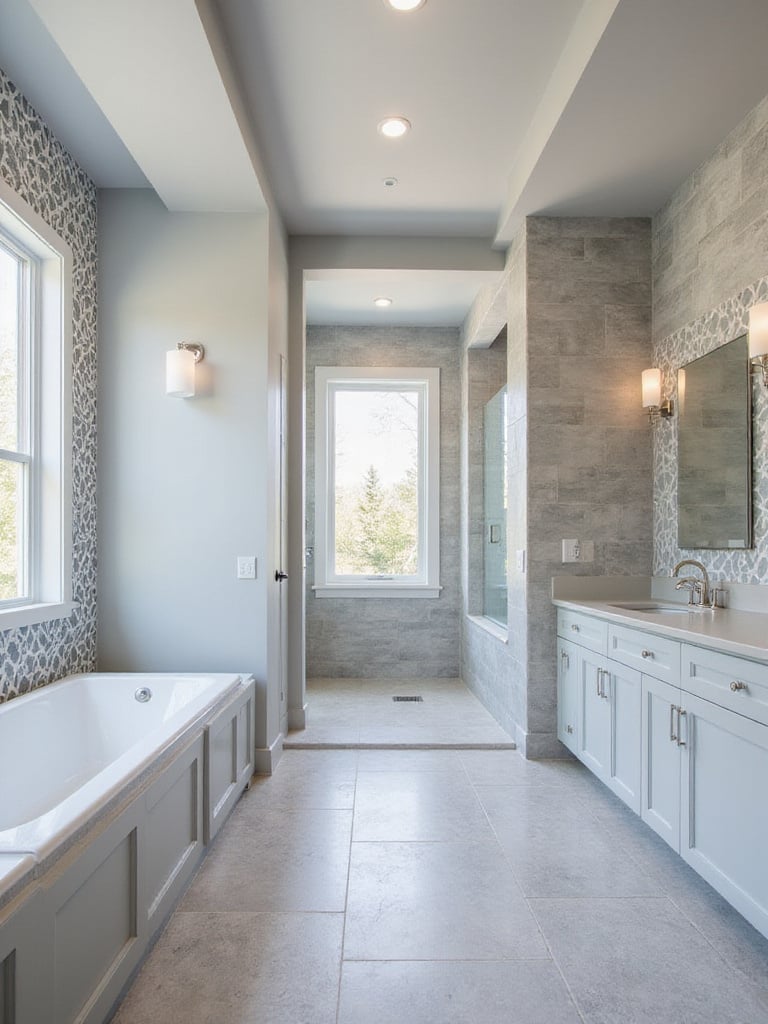
For painted areas, choose moisture-resistant formulations designed specifically for bathrooms, typically with satin or semi-gloss finishes that resist humidity and clean easily. Combining tile and paint strategically—using tile in wet zones and paint elsewhere—provides both protection and cost-effectiveness. Consider creating a dramatic accent wall behind your vanity using geometric patterns, zellige tiles, or large-format slabs with striking veining.
Modern bathrooms increasingly incorporate smart technology that enhances both convenience and luxury.
12. Integrating Smart Technology for a Modern Master Bath
We challenged ourselves to reimagine how technology could enhance daily routines without overwhelming the serene atmosphere essential to any bathroom remodel master retreat. Smart features range from practical additions like motion-sensing faucets and humidity-controlled exhaust fans to luxury elements like digital shower controls and heated toilet seats.
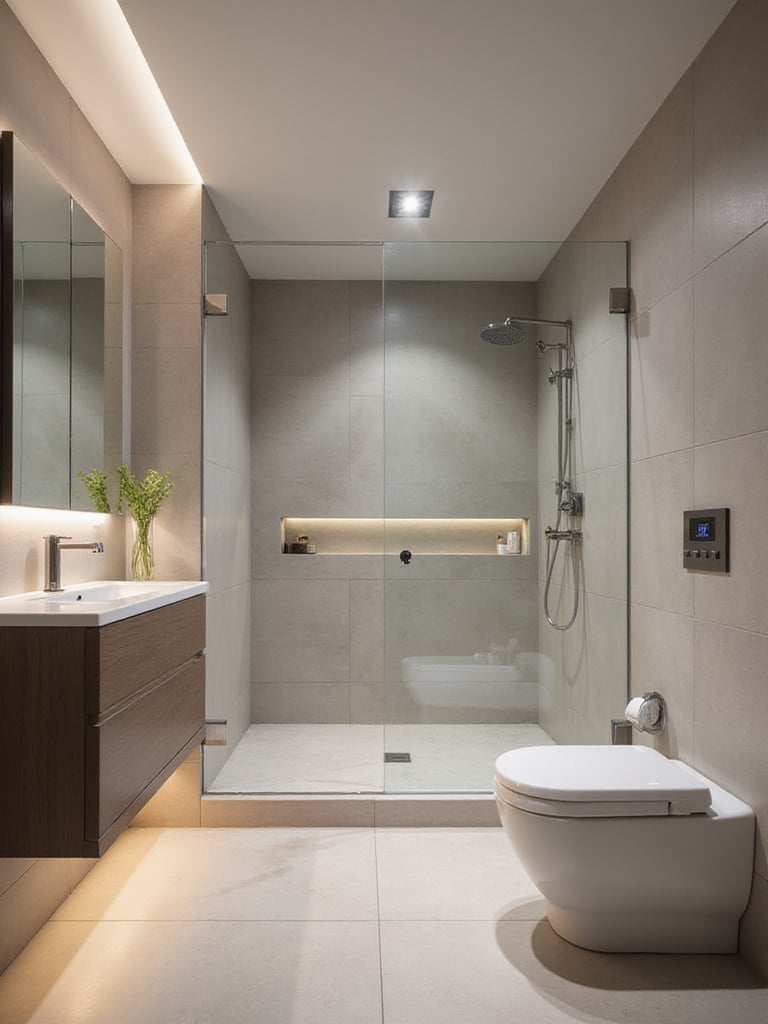
The key to successful integration lies in planning infrastructure during the construction phase. Ensure robust Wi-Fi coverage, adequate electrical outlets, and proper moisture ratings for all devices. Consider starting with simple upgrades like smart switches for lighting and ventilation, then expanding to more sophisticated systems as your comfort with the technology grows.
“Smart bathroom technology should enhance your daily routine, not complicate it. Start with features that solve real problems, then add luxury elements that bring genuine joy to your space.”
Planning for technology naturally extends to considering how your bathroom will serve you throughout different life stages.
13. Planning for the Future: Accessibility in Your Remodel
When clients ask us about balancing style with comfort, we emphasize how accessibility features can enhance any bathroom remodel master project without compromising aesthetics. Universal design principles create spaces that work beautifully for users of all ages and abilities, from young children to aging adults.
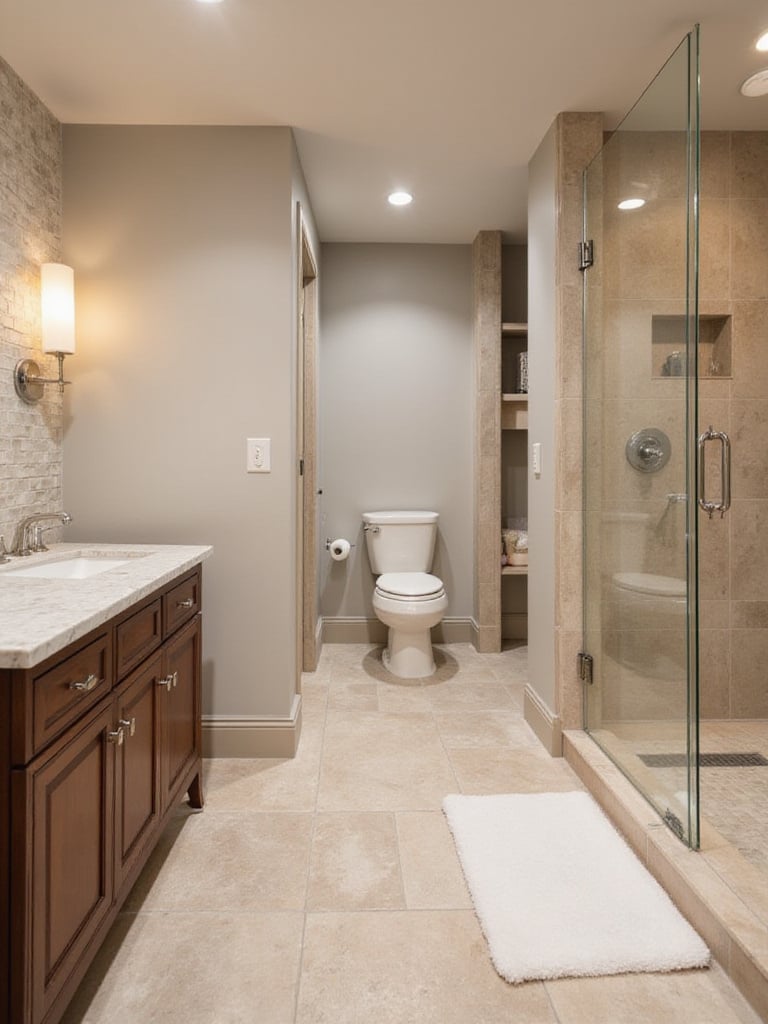
Key features include wider doorways (32-36 inches), curbless shower entries, comfort-height toilets, and reinforced walls for potential grab bar installation. These elements integrate seamlessly into contemporary design—a curbless shower with linear drain looks sleek and modern while providing barrier-free access. Lever-style faucets and door handles offer easier operation for everyone, regardless of hand strength or dexterity.
Implementing these features often requires professional expertise, making contractor selection a critical decision.
14. Finding the Right Contractor: Your Remodel Partner
The challenge of awkward spaces becomes easier when you find a contractor who truly understands the complexities of a bathroom remodel master project. This professional relationship can make or break your renovation experience, affecting everything from timeline adherence to final quality and budget management.
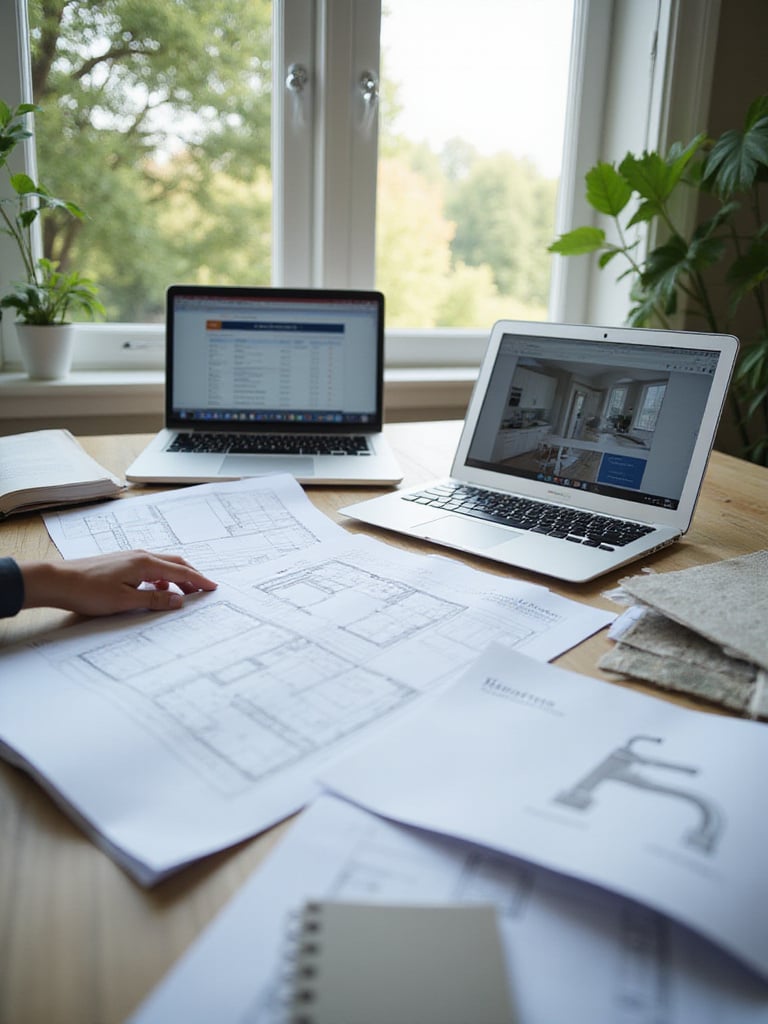
Start by gathering recommendations from trusted sources and checking online reviews on platforms like Houzz and Angi. Interview multiple candidates, asking about their experience with similar projects, licensing and insurance status, typical timelines, and approach to unexpected issues. Request references from recent clients and actually contact them. A reputable contractor will provide detailed written estimates and contracts, never pressure you for large upfront payments, and communicate clearly throughout the process.
The decision between professional installation and DIY work requires honest assessment of your skills and available time.
15. DIY or Pro? Deciding Your Master Remodel Path
Professional stylists approach this by first honestly assessing which tasks match their skill level and which require specialized expertise in a bathroom remodel master project. While DIY work can reduce labor costs, mistakes in critical areas like waterproofing or electrical work often cost more to fix than professional installation would have cost initially.

Consider a hybrid approach: tackle manageable tasks like demolition, painting, or simple fixture installation while hiring professionals for complex plumbing, electrical work, and tile installation. This strategy leverages your abilities while ensuring critical systems are properly installed and warranted. Remember that some work requires permits and inspections—professionals navigate these requirements efficiently.
Understanding the typical project phases helps set realistic expectations for your renovation timeline.
16. Navigating the Timeline: What to Expect During the Project
The evolution of this trend reflects broader cultural shifts toward realistic planning, as most bathroom remodel master projects require 4-8 weeks depending on scope and complexity. The process typically flows through distinct phases: planning and permits, demolition, rough plumbing and electrical, framing and drywall, flooring and tile, fixtures and finishes, and final cleanup.

Delays often stem from unexpected discoveries during demolition, material shipping delays, or permitting issues. Maintain open communication with your contractor and build buffer time into your expectations. Your role includes making timely decisions, ensuring access to the work area, and being available for questions that arise during construction.
Hidden plumbing issues represent one of the most common sources of unexpected delays and costs.
17. Plumbing Pointers: Avoiding Hidden Issues
The discovery of this technique happened when contractors began using cameras to inspect drain lines before demolition, revealing issues that could derail any bathroom remodel master timeline. Aging pipes, small leaks, and inadequate venting often lurk behind walls, invisible until renovation begins.

Professional plumbing inspection before demolition can identify potential problems early. Consider this especially important in homes over 20 years old or those with previous DIY plumbing work. While addressing these issues adds cost, handling them during renovation prevents future failures and water damage. Pressure testing new supply lines and running water through new drains before closing walls ensures everything functions properly.
Electrical work requires equal attention to safety and code compliance throughout your renovation.
18. Electrical Excellence: Powering Your New Bathroom
The maker’s journey from apprentice to master influenced our understanding of how proper electrical planning supports every aspect of a bathroom remodel master project. GFCI (Ground Fault Circuit Interrupter) protection is mandatory for all bathroom outlets, providing essential protection against electrical shock in wet environments.

Modern master bathrooms often require more circuits than older homes provide. Plan for adequate outlets near vanities, potential future smart fixtures, and features like heated floors or towel warmers. Consider USB-equipped outlets for device charging and smart switches for lighting control. Always hire licensed electricians for bathroom work—the combination of electricity and moisture demands professional expertise.
With essential systems addressed, luxury features can truly elevate your daily experience.
19. Adding Those Luxury Touches: Heated Floors & Beyond
The ambiance evolves throughout the day as natural light interacts with luxury features that transform your bathroom remodel master project into a personal spa. Heated floors provide the ultimate comfort upgrade, especially appreciated during cold mornings when stepping onto warm tile feels like a small daily luxury.

Electric radiant heating systems work well for bathroom applications, installing beneath tile or stone floors with dedicated thermostats for precise control. Other luxury additions might include heated towel racks, steam shower capabilities, or high-end shower systems with multiple heads and digital controls. Plan electrical and plumbing requirements for these features during the rough-in phase to avoid costly retrofitting.
Even in smaller master bathrooms, smart design choices can create surprisingly spacious and functional environments.
20. Making the Most of a Small Master Bathroom
For those worried about maintenance in compact spaces, strategic design choices can make even modest master bathroom remodel projects feel surprisingly spacious and luxurious. The key lies in maximizing every square inch while maintaining clean, uncluttered aesthetics that don’t overwhelm the space.

Wall-mounted vanities create visible floor space that makes rooms feel larger, while large mirrors reflect light and visually double the space. Choose light colors for major surfaces, incorporate adequate lighting to eliminate dark corners, and consider pocket doors or barn doors that don’t require swing clearance. vertical storage solutions and recessed niches provide necessary storage without protruding into the room.
All these practical considerations come together in creating a cohesive color palette and aesthetic vision.
21. Crafting Your Color Palette and Overall Aesthetic
The design language evolved from traditional patterns that now inform contemporary bathroom remodel master projects seeking timeless appeal with personal character. Your color palette sets the emotional tone for the entire space—cool blues and grays create spa-like serenity, while warm neutrals provide cozy sophistication.

Start with permanent elements like tile and countertops in neutral tones, then introduce personality through paint colors, textiles, and accessories that can evolve over time. Consider how colors appear under different lighting conditions throughout the day. Create a physical mood board with actual samples to ensure all elements work harmoniously together before making final selections.
Once construction concludes, proper cleanup and final details ensure your vision reaches its full potential.
22. The Final Polish: Post-Remodel Cleanup & Details
The finishing touch that elevates the entire look comes through meticulous post-construction cleanup that reveals the true beauty of your completed bathroom remodel master project. Construction dust penetrates everywhere, requiring specialized cleaning techniques and products to achieve that pristine, move-in-ready condition.

Professional post-construction cleaning services often prove worthwhile, as they possess the equipment and expertise to remove grout haze, construction residue, and fine dust that regular cleaning methods miss. They also understand how to clean new finishes without causing damage. Create a final walkthrough checklist to ensure all fixtures function properly, surfaces are pristine, and any punch list items are addressed.
A successful renovation considers not just immediate needs but long-term adaptability and durability.
23. Designing a Master Bathroom That Lasts: Future-Proofing Tips
The heritage technique gets a contemporary update through future-proofing strategies that ensure your bathroom remodel master investment serves you well for decades to come. This approach means selecting timeless materials, incorporating universal design principles, and planning for evolving technology and lifestyle needs.

Choose durable, low-maintenance materials like porcelain tile and quartz countertops that age gracefully. Install reinforcement for future grab bars even if not needed immediately. Plan electrical infrastructure that can accommodate future smart home technology. Design with sufficient clear floor space and consider aging-in-place features that benefit users of all ages and abilities.
Conclusion
Your bathroom remodel master journey represents more than a simple renovation—it’s an investment in daily comfort, long-term home value, and personal well-being. By following these 23 essential strategies, you’ve gained the knowledge to navigate complex decisions with confidence, from initial layout planning through final finishing touches.
The most successful projects balance aesthetic dreams with practical realities, incorporating quality materials and professional expertise where it matters most. Remember that this space will serve you for years to come, so prioritize durability, functionality, and timeless design over fleeting trends. With careful planning, realistic budgeting, and attention to detail, your master bathroom can become the serene retreat you’ve envisioned—a space that enhances your daily routine while adding lasting value to your home.






